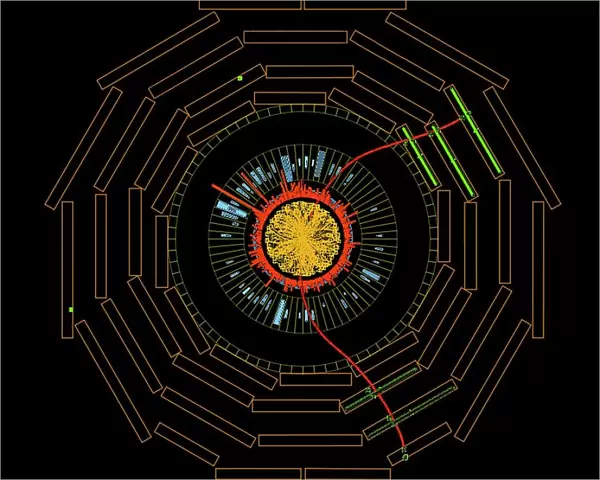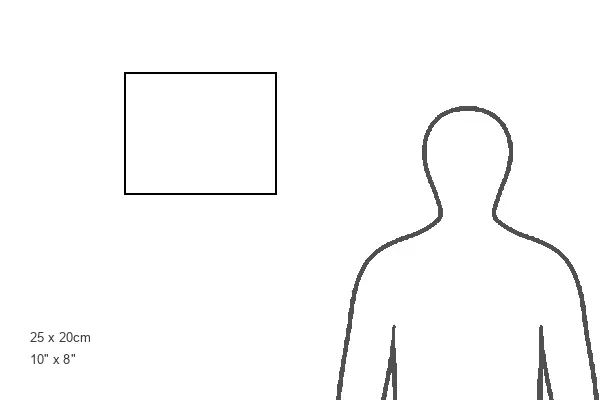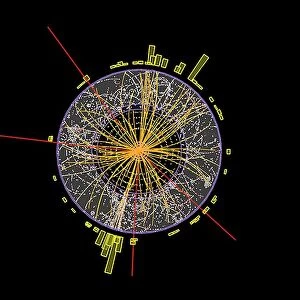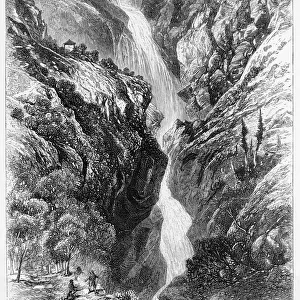Photographic Print > Europe > Switzerland > Geneva
Photographic Print : Lead ion collision C014 / 1793
![]()

Photo Prints from Science Photo Library
Lead ion collision C014 / 1793
Particle tracks from a lead ion collision seen by the CMS (compact muon solenoid) detector at CERN (the European particle physics laboratory) near Geneva, Switzerland. Before the collision the ions had been accelerated by the large hadron collider (LHC). The central tracking chamber (cylindrical) and muon chambers (red rectangles) of the detector are seen end-on in outline. The collision produced a number of unidentified particles (orange) and an upsilon meson. The upsilon meson is not seen, but is revealed through its decay products; a pair of muons (two longest red lines). The green lines show the energy deposited by the muons in the detectors muon chambers. The energies of the unidentified particles are measured by the electrochemical calorimeter (shorter red lines) and the hadron calorimeter (blue)
Science Photo Library features Science and Medical images including photos and illustrations
Media ID 9227761
© CMS EXPERIMENT, CERN/SCIENCE PHOTO LIBRARY
Apparatus Cern Collision Compact Muon Solenoid Cosmological Cosmology Decay Products Energy European Particle Physics Laboratory Experiment Fundamental Particles Geneva Hadrons Large Hadron Collider Matter Muon Particle Accelerator Particle Detector Particle Physics Particle Track Structure Of Matter Subatomic Particles Switzerland Trace Traces Tracks Trajectories Trajectory Physical
10"x8" Photo Print
Experience the mesmerizing world of subatomic physics with Media Storehouse's Photographic Prints. This captivating image, "Lead ion collision C014 / 1793" by CMS EXPERIMENT at CERN, brings the intrigue of particle physics right to your home or office. Witness the stunning beauty of lead ion collisions as captured by the Compact Muon Solenoid (CMS) detector at Europe's particle physics laboratory, CERN, located near Geneva, Switzerland. Each print is meticulously crafted for vibrant colors and exceptional detail, making it a unique addition to any scientific or artistic collection.
Photo prints are produced on Kodak professional photo paper resulting in timeless and breath-taking prints which are also ideal for framing. The colors produced are rich and vivid, with accurate blacks and pristine whites, resulting in prints that are truly timeless and magnificent. Whether you're looking to display your prints in your home, office, or gallery, our range of photographic prints are sure to impress. Dimensions refers to the size of the paper in inches.
Our Photo Prints are in a large range of sizes and are printed on Archival Quality Paper for excellent colour reproduction and longevity. They are ideal for framing (our Framed Prints use these) at a reasonable cost. Alternatives include cheaper Poster Prints and higher quality Fine Art Paper, the choice of which is largely dependant on your budget.
Estimated Product Size is 25.4cm x 20.3cm (10" x 8")
These are individually made so all sizes are approximate
Artwork printed orientated as per the preview above, with landscape (horizontal) or portrait (vertical) orientation to match the source image.
FEATURES IN THESE COLLECTIONS
> Europe
> Switzerland
> Geneva
> Europe
> Switzerland
> Posters
> Europe
> Switzerland
> Related Images
EDITORS COMMENTS
This print captures the aftermath of a lead ion collision, revealing intricate particle tracks observed by the CMS (compact muon solenoid) detector at CERN, near Geneva, Switzerland. Prior to this collision, the lead ions were accelerated by the powerful Large Hadron Collider (LHC), an extraordinary particle accelerator. In this image, we can see the outline of the central tracking chamber and muon chambers of the detector from an end-on perspective. The collision resulted in various unidentified particles depicted in orange, along with a significant discovery - an upsilon meson. Although not directly visible here, its presence is unveiled through its decay products: a pair of muons represented by two elongated red lines. The green lines represent the energy deposited by these muons within the detectors' muon chambers. Additionally, shorter red lines indicate measurements of energy from unidentified particles using both electrochemical calorimeter and hadron calorimeter (blue). This groundbreaking experiment conducted at CERN's European particle physics laboratory provides valuable insights into fundamental particles and their trajectories. It contributes to our understanding of subatomic structures and sheds light on cosmological matters such as dark matter and energy. The collaboration between cutting-edge technology like CMS and high-energy collisions enables scientists to unravel mysteries surrounding matter's composition and explore new frontiers in particle physics. This remarkable photograph serves as a testament to humanity's relentless pursuit of knowledge about our universe's building blocks.
MADE IN THE USA
Safe Shipping with 30 Day Money Back Guarantee
FREE PERSONALISATION*
We are proud to offer a range of customisation features including Personalised Captions, Color Filters and Picture Zoom Tools
SECURE PAYMENTS
We happily accept a wide range of payment options so you can pay for the things you need in the way that is most convenient for you
* Options may vary by product and licensing agreement. Zoomed Pictures can be adjusted in the Cart.





